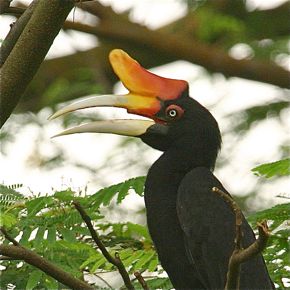For most of 2006 and after, a Great Hornbill (Buceros bicronis) and a Rhinoceros Hornbill (Buceros rhinoceros), both had somehow escaped from captivity, were seen regularly at a patch of secondary growth at Eng Neo (1 and 2). The pair was prospecting a tree cavity along the trunk of an old albezia tree (Paraserianthes falcataria), a normal courtship ritual in hornbills. Obviously there would be no breeding as the pair was of different species, besides both being females.
In early 2009, The Sin’apore Hornbill Project trapped the pair, caged the Great in the Jurong BirdPark and later released the Rhinoceros.
The plan was to re-introduce a male Rhinoceros Hornbill into the wild to provide a mate for the female Rhinoceros, now that its female Great companion was safely caged.
The caged male Rhinoceros was left at the Bukit Timah Nature Reserve to attract the free-flying female Rhinocrous, and hopefully the two would bond and take the “straight and narrow” path.
The female Rhinoceros did initially visit the caged male but subsequently left, never to return. However, a resident from nearby Johor in Malaysia reported seeing a Rhinoceros Hornbill flying around the Johor Baru padang in late 2009. This could possibly be the missing bird. As of today, the missing Rhinoceros Hornbill has yet to be located, despite the GPS tracking device attached to it, which by now would no longer be working.
Meanwhile the caged male escaped and was subsequently found by an amateur angler floating in the sea, probably as a result of exhaustion. The Jurong BirdPark was informed and the hornbill is now safely back in the park.
Hornbills apparently bond for life – I suppose regardless of whether they are of different species, in addition to being of the same sex. After all, don’t they mate “for better or for worse”?
This may well be wishful thinking, but now that we know the female Rhinoceros is not interested in a male bird of the same species, should not the female Great that is currently caged in the Jurong BirdPark be released? …in an effort to lure back the missing female Rhinoceros and allow both to fly free? After all, the escaped female Great had been enjoying her freedom for probably more than a decade, as sightings of Great Hornbills were reported as early as 1986.
Admittedly the Great Hornbill is not native to Singapore, and conventional wisdom believes that it should be caged, but Singapore is constantly seeing exotic birds flying freely. Recently two other exotic hornbill species were sighted – Narcondam Hornbill (Rhyticeros narcondami) that is confined to the Narcondam and Andaman Islands and Southern Ground Hornbill (Bucorvus leadbeateri), found in parts of Kenya, Burundi, Angola, Namibia, Botswana and South Africa. I wonder where these two species escaped from?
Anyone sighting a stray Rhinoceros Hornbill in Singapore or nearby Johor, please keep us informed. Marc Cremades, who is spearheading the Singapore Hornbill Project, is eager to locate the wayward bird. The bird can be recognised by the GPS pack attached to its back.
YC Wee
Singapore
January 2010










3 Responses
I have a few queires regarding the status of individual Narcondam hornbills in Singapore. From this recent post, what is the current status of the escaped juvenile Narcondam hornbill, is it still alive? Has anyone seen it recently? Is the adult female captive (with clipped wings) Narcondam at Dempsey Road still alive? Is there a possibility of contacting the owner? Does anyone have details for this, since I would like to ask for help regarding my student research. Thank you and I hope you can help me.
interesting update, I have seen a rhinoceros hornbill flying in temengor lake, and they can fly very far, so it is possible that the female rhino has crossed the strait of Johore, the male must not as tough as the female, maybe too long in the cage. so, my questions are:
1. will the authority in Johore help to locate and return the hornbill?
2. will the NP continue to re-introduce this species?
3. will the NP reintroduce another two species of hornbills, the helmeted and wrinkled?
I cannot answer questions 1 and 2 but as far as 3 is concerned, probably no. Why? Because helmeted and wrinkled are not native to Singapore.